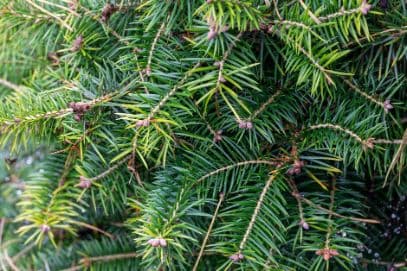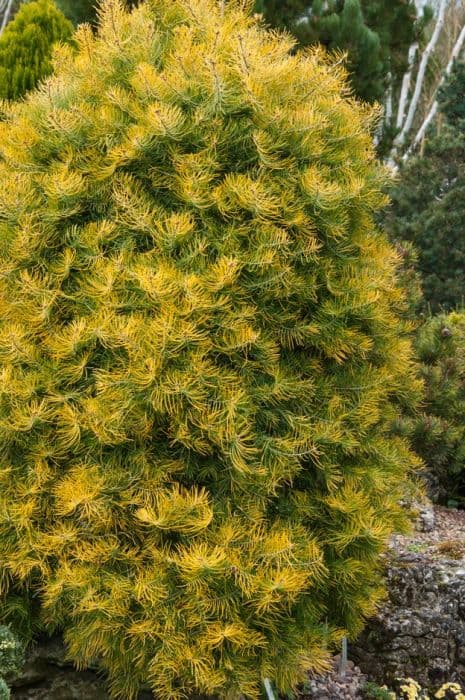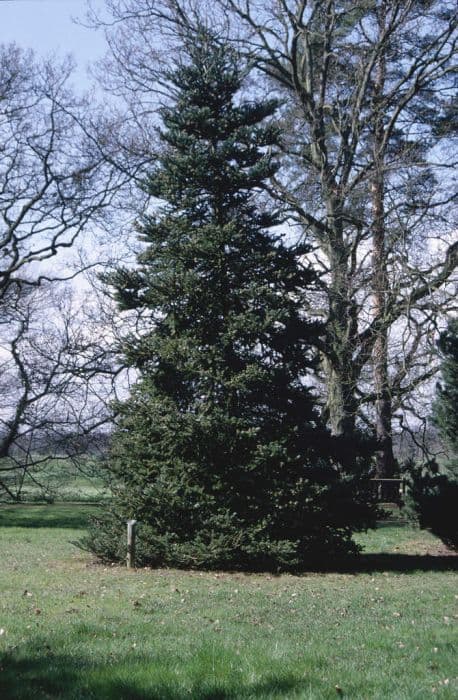Blue Atlas Cedar Cedrus atlantica 'Fastigiata'

ABOUT
The plant commonly known as Atlantic Cedar 'Fastigiata' is an ornamental conifer with a strikingly upright and columnar growth habit. It boasts dense branches that grow in an erect manner, making it a distinct feature in any landscape. The foliage of this cedar plant is composed of short, rigid needles that display a beautiful bluish-green hue, often exuding a silvery sheen when caught in the light. These needles cluster in tufts, emitting a pleasant aroma that is characteristic of cedar trees. As a slow-growing variety, the 'Fastigiata' maintains a compact and narrow silhouette, which sets it apart from other members of its species that tend more towards broadness. Its branches start from the lower trunk and ascend vertically, tightly clothed in its attractive foliage. During the year, the color of the needles remains fairly consistent, but some subtle color changes can be observed as the seasons transition, adding to its visual interest. Younger specimens have a sharply conical form, but as the plant matures, it develops a more distinctly columnar shape, with the tight growth of its branches creating a dense screen. This makes the Atlantic Cedar 'Fastigiata' particularly valuable for creating vertical accents in landscapes or gardens where space may be limited. The tree's bark is also noteworthy for its rough, gray texture that provides a stark contrast to the smooth and graceful foliage. In terms of its reproductive elements, this cedar produces small, upright cones that start off green and mature to a woody brown, adding another layer of texture and interest to the plant. These cones are relatively inconspicuous when compared to the lush foliage. Overall, the Atlantic Cedar 'Fastigiata' is an elegant and evergreen addition to a garden setting, known for its unique form and the tranquil presence it establishes in its surroundings.
About this plant
 Names
NamesFamily
Pinaceae
Synonyms
Blue Atlas Cedar, Columnar Blue Atlas Cedar
Common names
Cedrus atlantica 'Fastigiata'.
 Toxicity
ToxicityTo humans
The Atlas cedar generally is not considered toxic to humans. There are no well-documented cases of poisoning from this plant, which means that incidental ingestion of its leaves, wood, or sap is unlikely to cause harm. However, as with many plants, individual allergies may exist, and people with plant sensitivities should handle plants with caution.
To pets
The Atlas cedar is not commonly listed as a toxic plant for pets, including dogs and cats. It is not known to cause serious poisoning if pets ingest parts of the plant. While it is always recommended to keep an eye on pets when they are around plants, this particular species does not typically pose a threat to their health. However, consuming non-food items can potentially lead to gastrointestinal upset in pets, so it's still a good practice to prevent pets from ingesting large amounts of any plant material.
 Characteristics
CharacteristicsLife cycle
Perennials
Foliage type
Evergreen
Color of leaves
Blue-green
Height
40-60 feet (12-18 meters)
Spread
10-15 feet (3-4.5 meters)
Plant type
Tree
Hardiness zones
6-9
Native area
Africa
Benefits
 General Benefits
General Benefits- Aesthetic Appeal: Adds visual interest to landscapes with its unique, upright growth habit and attractive blue-green needles.
- Drought Tolerance: Once established, it requires minimal water, making it suitable for xeriscaping and water-wise gardens.
- Low Maintenance: Needs little pruning or care once established, saving time and effort for gardeners.
- Longevity: Can live for many decades, providing lasting structure in a garden or landscape.
- Wildlife Habitat: Offers shelter and nesting sites for birds, enhancing biodiversity.
- Urban Tolerance: Can withstand urban pollution and is suitable for city environments.
- Windbreak: Effective at providing protection from winds when planted in rows or groups.
- Soil Erosion Control: The tree's root system can help to stabilize soil on slopes and prevent erosion.
- Seasonal Interest: Provides year-round interest due to its evergreen nature.
- Suitable for Containers: Can be grown in large containers for patios or terraces where ground planting isn't possible.
 Medical Properties
Medical PropertiesThis plant is not used for medical purposes.
 Air-purifying Qualities
Air-purifying QualitiesThis plant is not specifically known for air purifying qualities.
 Other Uses
Other Uses- Cedarwood oil is derived from the foliage of the Atlas Cedar and is used in perfumery and aromatherapy for its woody, warming scent.
- The wood of the Atlas Cedar is valued for its resistance to rot and insects, making it ideal for outdoor construction such as shingles, decks, and fencing.
- Fine woodworking and cabinetry appreciate the wood's grain and durability, crafting high-quality furniture and decorative items.
- In landscaping, the Atlas Cedar is used to create visual interest with its distinct, upright growth habit, serving as a focal point in garden design.
- The tree's tall and narrow form makes it a popular choice for privacy screens and windbreaks in residential and public gardens.
- Due to its dense branching, the Atlas Cedar provides habitat and nesting sites for various bird species, enhancing biodiversity.
- The Atlas Cedar's root system helps in soil conservation by stabilizing slopes and preventing erosion in hilly or mountainous areas.
- Its durable and aromatic wood is used for crafting musical instruments, especially in regions where cedarwood is traditionally preferred.
- In cultural practices, branches and foliage of the Atlas Cedar are used in ceremonial events for decoration or as a symbol of strength and endurance.
- Atlas Cedar tree bark, rich in tannins, was historically used for tanning leather, a tradition that still exists in some regions.
Interesting Facts
 Feng Shui
Feng ShuiThe Blue Atlas Cedar is not used in Feng Shui practice.
 Zodiac Sign Compitability
Zodiac Sign CompitabilityThe Blue Atlas Cedar is not used in astrology practice.
 Plant Symbolism
Plant Symbolism- Strength: Cedrus atlantica, commonly known as the Atlas Cedar, often symbolizes strength due to its hardy nature and long-lasting wood.
- Resilience: The ability of the Atlas Cedar to withstand harsh conditions and grow in challenging environments makes it a symbol of resilience.
- Endurance: As an evergreen, the Atlas Cedar represents endurance and eternal life, staying green throughout the seasons.
- Nobility: With its majestic posture, the Atlas Cedar symbolizes nobility and dignity.
- Sanctity: Historically, cedars have been revered as sacred trees, and the Atlas Cedar carries a sense of sanctity and spiritual significance.
- Peace: The tree's calming presence and association with serene mountain settings give it a symbolic connection to peace and tranquility.
 Water
WaterThe Atlantic Cedar 'Fastigiata' should be watered deeply and infrequently to mimic its natural habitat and encourage deep root growth. During the first growing season, water the plant once a week with about 10 to 15 gallons to establish a good root system. After establishment, the watering frequency can be reduced depending on weather conditions; generally, watering every two to three weeks with the same amount of water is sufficient. Adjust the schedule during hot, dry periods to prevent drought stress, and reduce watering in the fall before the first frost to allow the plant to harden off for winter.
 Light
LightThe Atlantic Cedar 'Fastigiata' thrives best in full sun conditions and should be planted in a location where it receives at least six hours of direct sunlight each day. Avoid shaded areas, as insufficient light can impede the plant's growth and health. This cedar variety performs well when it has ample light exposure throughout the day, which promotes dense foliage and a robust structure.
 Temperature
TemperatureThe Atlantic Cedar 'Fastigiata' is hardy and can tolerate a wide range of temperatures, with an ideal growing range between 40°F and 70°F. This cedar variety can withstand minimum temperatures down to about -20°F and can adapt to heat, though it prefers cooler summer temperatures. Protection from extreme winter winds and proper siting can reduce the risk of damage from cold temperatures.
 Pruning
PruningPruning the Atlantic Cedar 'Fastigiata' is generally not necessary as it naturally grows in a compact, upright form. If pruning is required to remove dead or damaged branches, it should be done in the late winter or early spring before new growth starts. Avoid heavy pruning, as cedars do not readily sprout new growth from old wood, and the pruning cuts should be clean and precise to maintain the tree's natural shape.
 Cleaning
CleaningAs needed
 Soil
SoilThe Columnar Atlas Cedar prefers a well-draining soil mix with sandy or loamy components, and appreciates neutral to slightly acidic pH levels, ideally between 6.0 to 7.5.
 Repotting
RepottingThe Columnar Atlas Cedar being a slow-growing conifer, typically doesn't require frequent repotting; doing so every 3 to 5 years is sufficient unless it is pot-bound.
 Humidity & Misting
Humidity & MistingThe Columnar Atlas Cedar is tolerant of a wide range of humidity conditions and does well in outdoor humidity levels without specific requirements.
 Suitable locations
Suitable locationsIndoor
Place in a bright spot, avoid hot, dry air.
Outdoor
Sunny location, well-draining soil, shelter from winds.
Hardiness zone
6-9 USDA
 Life cycle
Life cycleFor the Atlas Cedar (Cedrus atlantica 'Fastigiata'), the life cycle begins with seed germination, which typically requires a period of cold stratification. After stratification, seeds will germinate in favorable conditions, establishing a root system and a primary shoot. The seedling then develops into a juvenile tree, characterized by a fastigiate, or upright and narrow, growth habit. This juvenile phase can last for several years until the tree reaches maturity, showing a broadening of form and producing cones. The reproductive phase includes the development of male and female cones; the male cones release pollen, which fertilizes the ovules in the female cones. After fertilization, seeds are produced within the female cones, and when mature, they are released to start a new generation, completing the life cycle.
 Propogation
PropogationPropogation time
Late Winter-Spring
Cedrus atlantica 'Fastigiata', commonly known as the Blue Atlas Cedar, is best propagated by semi-hardwood cuttings. This method is usually undertaken in late summer or early autumn when new growth has matured and started to harden slightly. For a successful propagation, cuttings should be about 6 to 8 inches (15 to 20 centimeters) in length and contain several sets of needles. After cutting, the lower needles are stripped, and the base is dipped in a rooting hormone to encourage root development. The prepared cutting is then placed in a well-draining rooting medium and kept in a humid environment until roots establish, which can take several months. A key to success is ensuring consistent moisture and avoiding direct sunlight during the rooting process to prevent the cuttings from drying out or becoming overheated.









